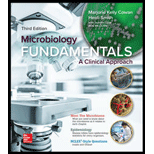
Microbiology Fundamentals: A Clinical Approach
3rd Edition
ISBN: 9781259709227
Author: Marjorie Kelly Cowan Professor, Heidi Smith
Publisher: McGraw-Hill Education
expand_more
expand_more
format_list_bulleted
Concept explainers
Question
Chapter 10.4, Problem 23AYP
Summary Introduction
To describe:
Superinfection and its occurrence.
Concept introduction:
While treating an infection caused by a microbe, the drug that is administered has some effects on human tissues also. Many people taking antimicrobial drugs experience some kind of side effects to it. Drugs with side effects can either directly damage the host tissues by toxicity, or by allergic reactions. The damage caused can be highly severe of just cosmetic.
Expert Solution & Answer
Want to see the full answer?
Check out a sample textbook solution
Students have asked these similar questions
What is the structure and function of Eukaryotic cells, including their organelles? How are Eukaryotic cells different than Prokaryotic cells, in terms of evolution which form of the cell might have came first? How do Eukaryotic cells become malignant (cancerous)?
What are the roles of DNA and proteins inside of the cell? What are the building blocks or molecular components of the DNA and proteins? How are proteins produced within the cell? What connection is there between DNA, proteins, and the cell cycle? What is the relationship between DNA, proteins, and Cancer?
Why cells go through various types of cell division and how eukaryotic cells control cell growth through the cell cycle control system?
Chapter 10 Solutions
Microbiology Fundamentals: A Clinical Approach
Ch. 10.1 - State the main goal of antimicrobial treatment.Ch. 10.1 - Identify the sources for the most commonly used...Ch. 10.1 - Describe two methods for testing antimicrobial...Ch. 10.1 - Prob. 4AYPCh. 10.1 - NCLEX PREP 1. An RN is caring for a 26-year-old...Ch. 10.2 - Explain the concept of selective toxicity.Ch. 10.2 - List the five major targets of antimicrobial...Ch. 10.2 - Prob. 7AYPCh. 10.2 - Distinguish between broad-spectrum and...Ch. 10.2 - Prob. 9AYP
Ch. 10.2 - Explain the mode of action of penicillinases and...Ch. 10.2 - Identify two antimicrobials that act by inhibiting...Ch. 10.2 - Prob. 12AYPCh. 10.2 - Identify one example of a fluoroquinolone.Ch. 10.2 - Describe the mode of action of drugs that target...Ch. 10.2 - Prob. 15AYPCh. 10.2 - Prob. 16AYPCh. 10.2 - Explain why antiprotozoal and antihelminthic drugs...Ch. 10.2 - List the three major targets of action of...Ch. 10.2 - Prob. 2NPCh. 10.3 - Discuss two main ways that microbes acquire...Ch. 10.3 - List five cellular or structural mechanisms that...Ch. 10.3 - Prob. 21AYPCh. 10.3 - Prob. 3NPCh. 10.3 - Prob. 1MMCh. 10.4 - Distinguish between drug toxicity and allergic...Ch. 10.4 - Prob. 23AYPCh. 10.4 - Prob. 4NPCh. 10.4 - Prob. 5NPCh. 10 - Microbial resistance to drugs is acquired through...Ch. 10 - Prob. 2QCh. 10 - Prob. 3QCh. 10 - Prob. 4QCh. 10 - Why does the penicillin group of antibiotics have...Ch. 10 - Prob. 6QCh. 10 - Prob. 7QCh. 10 - Conduct research to find out why drugs blocking...Ch. 10 - Prob. 9QCh. 10 - Prob. 10QCh. 10 - You take a sample from a growth-free portion of...Ch. 10 - Prob. 12QCh. 10 - Treating malarial infections is theoretically...Ch. 10 - Can you think of a situation in which it would be...Ch. 10 - Prob. 15QCh. 10 - Prob. 16QCh. 10 - Prob. 17QCh. 10 - Prob. 18QCh. 10 - An antimicrobial drug with a _______ therapeutic...Ch. 10 - Prob. 20QCh. 10 - Prob. 21QCh. 10 - Prob. 1VC
Knowledge Booster
Learn more about
Need a deep-dive on the concept behind this application? Look no further. Learn more about this topic, biology and related others by exploring similar questions and additional content below.Similar questions
- In one paragraph show how atoms and they're structure are related to the structure of dna and proteins. Talk about what atoms are. what they're made of, why chemical bonding is important to DNA?arrow_forwardWhat are the structure and properties of atoms and chemical bonds (especially how they relate to DNA and proteins).arrow_forwardThe Sentinel Cell: Nature’s Answer to Cancer?arrow_forward
- Molecular Biology Question You are working to characterize a novel protein in mice. Analysis shows that high levels of the primary transcript that codes for this protein are found in tissue from the brain, muscle, liver, and pancreas. However, an antibody that recognizes the C-terminal portion of the protein indicates that the protein is present in brain, muscle, and liver, but not in the pancreas. What is the most likely explanation for this result?arrow_forwardMolecular Biology Explain/discuss how “slow stop” and “quick/fast stop” mutants wereused to identify different protein involved in DNA replication in E. coli.arrow_forwardMolecular Biology Question A gene that codes for a protein was removed from a eukaryotic cell and inserted into a prokaryotic cell. Although the gene was successfully transcribed and translated, it produced a different protein than it produced in the eukaryotic cell. What is the most likely explanation?arrow_forward
- Molecular Biology LIST three characteristics of origins of replicationarrow_forwardMolecular Biology Question Please help. Thank you For E coli DNA polymerase III, give the structure and function of the b-clamp sub-complex. Describe how the structure of this sub-complex is important for it’s function.arrow_forwardMolecular Biology LIST three characteristics of DNA Polymerasesarrow_forward
arrow_back_ios
SEE MORE QUESTIONS
arrow_forward_ios
Recommended textbooks for you
- Surgical Tech For Surgical Tech Pos CareHealth & NutritionISBN:9781337648868Author:AssociationPublisher:Cengage



Surgical Tech For Surgical Tech Pos Care
Health & Nutrition
ISBN:9781337648868
Author:Association
Publisher:Cengage


